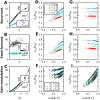Interpretation of correlated neural variability from models of feed-forward and recurrent circuits
- PMID: 29408930
- PMCID: PMC5833435
- DOI: 10.1371/journal.pcbi.1005979
Interpretation of correlated neural variability from models of feed-forward and recurrent circuits
Abstract
Neural populations respond to the repeated presentations of a sensory stimulus with correlated variability. These correlations have been studied in detail, with respect to their mechanistic origin, as well as their influence on stimulus discrimination and on the performance of population codes. A number of theoretical studies have endeavored to link network architecture to the nature of the correlations in neural activity. Here, we contribute to this effort: in models of circuits of stochastic neurons, we elucidate the implications of various network architectures-recurrent connections, shared feed-forward projections, and shared gain fluctuations-on the stimulus dependence in correlations. Specifically, we derive mathematical relations that specify the dependence of population-averaged covariances on firing rates, for different network architectures. In turn, these relations can be used to analyze data on population activity. We examine recordings from neural populations in mouse auditory cortex. We find that a recurrent network model with random effective connections captures the observed statistics. Furthermore, using our circuit model, we investigate the relation between network parameters, correlations, and how well different stimuli can be discriminated from one another based on the population activity. As such, our approach allows us to relate properties of the neural circuit to information processing.
Conflict of interest statement
The authors have declared that no competing interests exist.
Figures








Similar articles
-
Stochastic transitions into silence cause noise correlations in cortical circuits.Proc Natl Acad Sci U S A. 2015 Mar 17;112(11):3529-34. doi: 10.1073/pnas.1410509112. Epub 2015 Mar 4. Proc Natl Acad Sci U S A. 2015. PMID: 25739962 Free PMC article.
-
A discrete model of neural ensembles.Philos Trans A Math Phys Eng Sci. 2002 Mar 15;360(1792):559-73. doi: 10.1098/rsta.2001.0946. Philos Trans A Math Phys Eng Sci. 2002. PMID: 16214695
-
Stimulus-dependent correlations and population codes.Neural Comput. 2009 Oct;21(10):2774-804. doi: 10.1162/neco.2009.10-08-879. Neural Comput. 2009. PMID: 19635014
-
Neural population codes.Curr Opin Neurobiol. 2003 Apr;13(2):238-49. doi: 10.1016/s0959-4388(03)00034-5. Curr Opin Neurobiol. 2003. PMID: 12744980 Review.
-
The copula approach to characterizing dependence structure in neural populations.Chin J Physiol. 2010 Dec 31;53(6):373-81. doi: 10.4077/cjp.2010.amm036. Chin J Physiol. 2010. PMID: 21793349 Review.
Cited by
-
Multimodal Nature of the Single-cell Primate Brain Atlas: Morphology, Transcriptome, Electrophysiology, and Connectivity.Neurosci Bull. 2024 Apr;40(4):517-532. doi: 10.1007/s12264-023-01160-4. Epub 2024 Jan 9. Neurosci Bull. 2024. PMID: 38194157 Free PMC article. Review.
-
Efficient coding theory of dynamic attentional modulation.PLoS Biol. 2022 Dec 21;20(12):e3001889. doi: 10.1371/journal.pbio.3001889. eCollection 2022 Dec. PLoS Biol. 2022. PMID: 36542662 Free PMC article.
-
Sparse recurrent excitatory connectivity in the microcircuit of the adult mouse and human cortex.Elife. 2018 Sep 26;7:e37349. doi: 10.7554/eLife.37349. Elife. 2018. PMID: 30256194 Free PMC article.
References
-
- Kriener B, Tetzlaff T, Aertsen A, Diesmann M, Rotter S. Correlations and Population Dynamics in Cortical Networks. Neural Comput. 2008;20(9):2185–2226. doi: 10.1162/neco.2008.02-07-474 - DOI - PubMed
-
- Ostojic S, Brunel N, Hakim V. How connectivity, background activity, and synaptic properties shape the cross-correlation between spike trains. J Neurosci. 2009;29(33):10234–53. doi: 10.1523/JNEUROSCI.1275-09.2009 - DOI - PMC - PubMed
-
- Tetzlaff T, Helias M, Einevoll GT, Diesmann M. Decorrelation of neural-network activity by inhibitory feedback. PLoS Comput Biol. 2012;8(8):e1002596 doi: 10.1371/journal.pcbi.1002596 - DOI - PMC - PubMed
-
- Trousdale J, Hu Y, Shea-Brown E, Josić K. Impact of network structure and cellular response on spike time correlations. PLoS Comput Biol. 2012;8(3):e1002408 doi: 10.1371/journal.pcbi.1002408 - DOI - PMC - PubMed
-
- Renart A, la Rocha JD, Bartho P. The asynchronous state in cortical circuits. Science. 2010;327(5965):587–590. doi: 10.1126/science.1179850 - DOI - PMC - PubMed
Publication types
MeSH terms
LinkOut - more resources
Full Text Sources
Other Literature Sources
Research Materials

